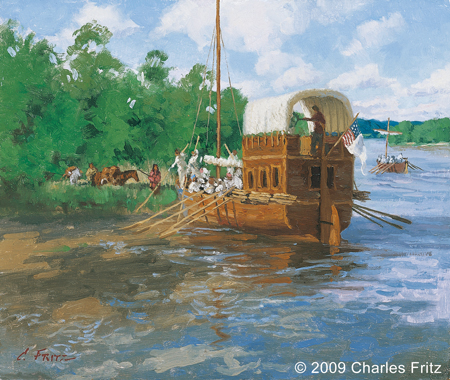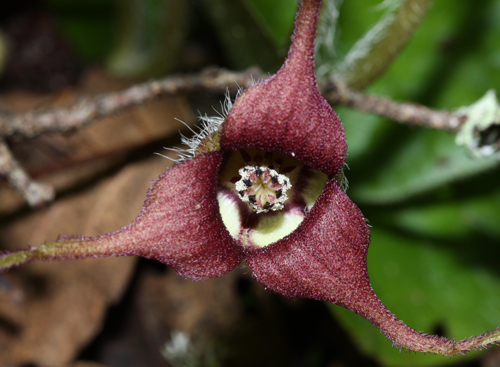The expedition struggles against a strong Missouri River current before stopping at the mouth of the Osage River. The captains take celestial observations late into the night to determine the precise location of this important tributary. Lewis also collects a specimen of wild ginger, Asarum canadense.
Arrival at the Osage River
by Yellowstone Public Radio[1]Originally aired weekdays by Yellowstone Public Radio during the Bicentennial observance of 2003-2006. Narrated by Hal Hansen. Scripts by Whit Hansen and Ed Jacobson. Produced by Leni Holliman. © … Continue reading
At the Mouth of the Osage River
10″ x 12″ oil on board
© 2009 by Charles Fritz. Used with permission.
Osage River
Before daylight we embarked and proceeded on our voyage . . . . at 4 o’clock P. M. arrived at the Osage river; where we remained during the evening and the next day. The Osage nation of Indians live about two hundred miles up this river. They are of a large size and well proportioned, and a very warlike people. Our arms and ammunition were all inspected here and found in good order.
—Patrick Gass
Late Night Observations
felled all the Trees in the point to Make observations Sit up untill 12 oClock taken oservation this night
—William Clark
Wild Ginger
Asarum canadense
Photo © 2008 Walter Siegmund. Permission to use granted under the Creative Commons Attribution-ShareAlike 3.0 Unported license./p>
Lost Specimen No. 10
No. 10. This plant was taken the 1st of June at the mouth of the Osage river; it is known in this country by the name of the wild ginger, it resembles that plant somewhat in both taste and effect; it is a strong stomatic stimelent, and frequently used in sperits with bitter herbs— it is common throughout the rich lands in the Western country.—
—Meriwether Lewis
Moulton identifies this lost specimen, received by John Vaughn in 1805 (see The Donation Book), as Asarum canadense L., wild ginger.[2]Gary E. Moulton, ed. Journals, “Fort Mandan Miscellany”, vol 3:453, 467.
Experience the Lewis and Clark Trail
The Lewis and Clark Trail Experience—our sister site at lewisandclark.travel—connects the world to people and places on the Lewis and Clark Trail.
Plan a trip related to June 1, 1804:

Clark’s Hill State Historic Site is a High Potential Historic Site along the Lewis and Clark National Historic Trail managed by the U.S. National Park Service. Since Clark described this viewpoint, the Osage mouth has shifted six miles further downstream. The site, managed by Missouri State Parks, provides public access.
Notes
| ↑1 | Originally aired weekdays by Yellowstone Public Radio during the Bicentennial observance of 2003-2006. Narrated by Hal Hansen. Scripts by Whit Hansen and Ed Jacobson. Produced by Leni Holliman. © 2003 by Yellowstone Public Radio. |
|---|---|
| ↑2 | Gary E. Moulton, ed. Journals, “Fort Mandan Miscellany”, vol 3:453, 467. |




